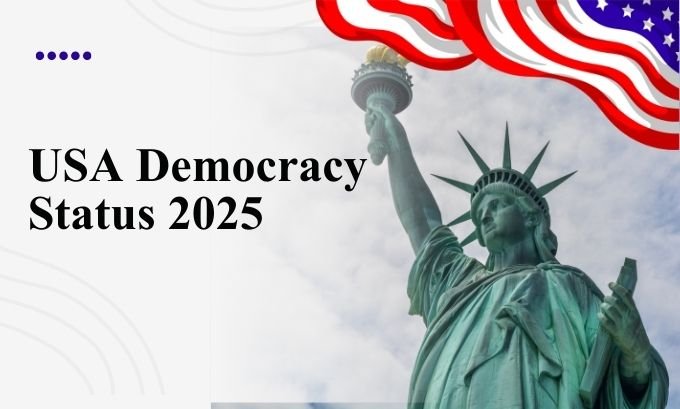The condition of democracy in the United States is a subject of intense global scrutiny. Growing concerns over the integrity of democratic norms, institutional health, and the scope of executive power have put the USA democracy status 2025 into sharp focus. This analysis delves into the critical developments, draws comparisons with global trends, and offers a balanced perspective on the challenges and resilience of the American democratic system.
Table of Contents
Assessing the USA Democracy Status 2025
The current evaluation of the USA democracy status 2025 reveals a system facing considerable strain. This situation is largely defined by a phenomenon called democratic backsliding, a process where a country’s democratic institutions are gradually weakened by its own elected leaders. This is not an isolated American issue; similar patterns have been documented in nations like Hungary under Viktor Orbán and Türkiye under Recep Tayyip Erdoğan.
During the second presidency of Donald Trump, the United States has experienced a clear push toward executive aggrandizement. This strategy involves consolidating power within the executive office, questioning the authority of other governmental branches like the judiciary, and weakening societal checks on power. These actions have ignited a national conversation about the future health and stability of American democracy.
Key Factors Defining the 2025 Landscape
Several pivotal actions have shaped the political environment in 2025:
- Executive Power Consolidation: A central objective has been to assert the president’s control over the entire executive branch. This has involved weakening internal accountability bodies, extending presidential influence over independent agencies, and politicizing the civil service. The commentary from figures like Elon Musk on government efficiency and restructuring has added an unconventional but notable dimension to this trend.
- Challenges to the Judiciary: The administration has frequently challenged the authority and legitimacy of the judiciary. These challenges have included public criticism of judges, questioning unfavorable court decisions, and even outright non-compliance with judicial orders, which touches on the core principles of the separation of powers.
- Shifts in Foreign Policy: A noticeable change has occurred in foreign policy, moving toward a more transactional model that de-emphasizes traditional alliances, including with the European Union (EU). This has created new dynamics in international relations, especially concerning Russia and the conflict in Ukraine, straining relationships with historic partners.
An Analyst’s View on Institutional Pressures
As a political analyst who has spent over a decade studying democratic erosion worldwide, I’ve seen these patterns play out before. For a long time, the United States was a model of democratic stability. Observing the events of 2025, however, feels like watching a familiar script being performed on a new stage.
I remember covering the initial phases of democratic backsliding in Hungary. At first, the changes were subtle: a restructuring of the courts, increased pressure on independent media, and a quiet centralization of executive authority. Many people didn’t notice the impact directly until years later when those institutional shifts began to influence their daily lives through court rulings or new regulations.

What is remarkable about the USA democracy status 2025 is the sheer velocity of the changes. The flurry of executive orders, the public confrontations with the judiciary, and the rapid personnel changes within key government agencies are occurring at a pace that is faster than what we observed in many other countries. It serves as a live case study of how quickly democratic norms, once thought to be ironclad, can be put to the test. My experience shows that no democracy is inherently immune to these pressures.
Strengths: The Enduring Pillars of U.S. Democracy
Despite significant pressures, the American democratic system continues to demonstrate areas of notable resilience.
- A Vocal Civil Society: Non-governmental organizations, advocacy groups, and community-led movements remain highly engaged, actively monitoring government actions and mobilizing public discourse.
- An Independent Press: While facing challenges, a diverse and independent media landscape continues to investigate and report on the administration, functioning as an essential watchdog.
- A Robust Institutional Framework: The U.S. Constitution provides a strong foundation with checks and balances that are difficult to dismantle. The structure of the legislature and the federal system creates multiple barriers that can slow or block sweeping changes.
- State-Level Counterbalance: State governments have emerged as significant counterweights, using their legal and political authority to challenge federal overreach on a variety of issues.
Areas for Improvement: Identified Vulnerabilities
The current political climate also highlights several key weaknesses within the system.
- The Fraying of Norms: The American system depends heavily on unwritten democratic norms, such as respect for judicial independence and the peaceful transfer of power. The erosion of these norms is more difficult to address than a legal challenge.
- Intense Political Polarization: Deep political divisions have made compromise nearly impossible, fostering a culture where legislative progress on critical reforms is often paralyzed.
- The Threat of Disinformation: The information ecosystem is vulnerable to disinformation campaigns that can undermine public trust in core institutions, including the press and the electoral process.
- The Expansion of Executive Power: The increasing use of executive orders and emergency declarations to bypass Congress has become a primary tool for advancing a centralized agenda, setting precedents that could permanently weaken legislative authority.
Democratic Backsliding: The U.S. in a Global Context
To fully grasp the situation in the United States, it is helpful to place it within a global context. The table below compares key aspects of democratic backsliding in the U.S. with other prominent examples.
| Feature | United States (2025) | Hungary (under Viktor Orbán) | Türkiye (under Recep Tayyip Erdoğan) |
|---|---|---|---|
| Pace of Erosion | Exceptionally rapid, with simultaneous pressures on multiple institutions. | Gradual at first, but accelerated significantly after securing a constitutional supermajority. | Incremental over two decades, marked by key constitutional referendums that consolidated power. |
| Primary Institutional Target | Focus on dominating the executive branch while delegitimizing the judiciary and Congress. | Used legislative and constitutional changes to gain control over the judiciary, media, and elections. | Employed constitutional reform to create a powerful executive presidency, weakening legislative and judicial checks. |
| Methods Used | Reliance on executive orders, defiance of court rulings, and personnel changes. Focus on normative erosion. | Utilized legislative action and constitutional amendments to institutionalize power grabs. | Leveraged legal reforms, referendums, and widespread purges of state officials to cement control. |
| Foreign Policy Alignment | Strained relations with the EU; complex and controversial posture toward Russia. | Tense relationship with the EU over rule-of-law concerns, while cultivating ties with Russia. | Maintained strategic but often contentious relationships with both Western powers and Russia. |
| Civil Society Status | Faces pressure and funding threats but remains largely free to operate and mobilize. | Systematically weakened through legal and financial restrictions that curtail its influence. | Severely repressed, with widespread arrests of journalists, academics, and activists. |
This comparison illustrates that while Donald Trump’s tactics share common elements with leaders like Viktor Orbán and Recep Tayyip Erdoğan, the unique strength of U.S. institutional guardrails has resulted in a strategy more focused on delegitimization rather than immediate institutional capture.

Frequently Asked Questions (FAQ)
1. What is the greatest threat to American democracy in 2025?
The most significant threat is democratic backsliding fueled by executive aggrandizement. This process involves a deliberate effort to centralize power by weakening institutional checks and balances, especially the independence of the judiciary and the oversight function of Congress.
2. How does the USA democracy status 2025 compare to other nations?
The U.S. exhibits many parallels with countries like Hungary and Türkiye, where elected leaders have systematically weakened democratic structures. However, the process in the U.S. is distinct for its rapid pace and its focus on eroding democratic norms rather than pursuing deep constitutional changes, which are more challenging to enact in the American system.
3. What is Donald Trump’s role in the current democratic landscape?
Donald Trump is the central figure advancing the agenda of executive aggrandizement. His policies and rhetoric are aimed at consolidating power, challenging institutional constraints, and delegitimizing opposition from all corners, including the media and the courts.
4. How has this situation affected international relations?
U.S. foreign policy has shifted to a more transactional approach, moving away from traditional alliances. This has strained relationships with bodies like the European Union (EU) and created uncertainty about American commitments, particularly regarding the conflict between Russia and Ukraine.
5. Are there any signs of democratic resilience in the United States?
Absolutely. A vibrant civil society, an independent press, a durable constitutional framework, and legal and political resistance from state governments all serve as powerful sources of democratic resilience. These forces are actively working to counter efforts at executive overreach.
6. What is the role of the judiciary in this political climate?
The judiciary has become a central arena of conflict. While the administration has attacked its legitimacy and challenged its rulings, the courts remain one of the most important institutional checks on executive power. The integrity and independence of the judiciary are fundamental to upholding the rule of law.
7. How does Elon Musk fit into discussions about U.S. governance?
Elon Musk has emerged as a high-profile, disruptive voice in conversations about government reform, advocating for a radical overhaul of the federal bureaucracy. Though not an official government figure, his influence reflects a broader anti-establishment sentiment aimed at dismantling traditional state institutions.
Conclusion: A Democracy at a Turning Point
The USA democracy status 2025 is defined by profound challenges and significant uncertainty. The nation is undergoing an unprecedented test of its democratic foundations, driven by a model of executive aggrandizement that reflects global trends. While the system’s core strengths—including a resilient civil society and a robust legal framework—continue to offer vital checks on power, the swift erosion of democratic norms poses a serious risk.
The future remains unwritten. The coming years will reveal whether the United States can withstand these pressures and reinforce its democratic ideals or if it will continue on a path of institutional decline. For citizens and international observers alike, remaining informed and engaged has never been more important.
Consider exploring in-depth reports from non-partisan policy institutes and academic centers to gain a deeper understanding of the forces shaping American democracy today.
For readers exploring the USA democracy status 2025, discover curated global products that reflect diverse cultures at Tokyo Mart
Author Bio:
This article was authored by a senior political analyst with over 15 years of experience covering global politics, democratic theory, and U.S. governance for leading publications and research institutions. Holding a Ph.D. in Political Science, the author specializes in comparative democratic studies and has conducted extensive fieldwork in Eastern Europe and Latin America, lending an expert, data-driven perspective to the analysis of democratic backsliding.
References:
- Carothers, T., & Carrier, M. (2025). U.S. Democratic Backsliding in Comparative Perspective. Carnegie Endowment for International Peace.
- Levitsky, S., & Ziblatt, D. (2018). How Democracies Die. Crown Publishing Group.
- Annual reports from Freedom House on the state of global democracy.
- Peer-reviewed publications on comparative politics, such as the Journal of Democracy.


